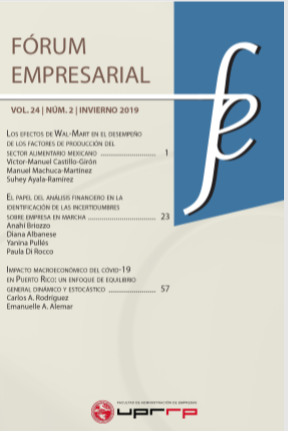Abstract
The aim of this work is to empirically analyze the relationship of financial ratios and firm characteristics with the inclusion of an emphasis paragraph for uncertainty related to the going concern assumption in the auditor‘s report. The firms that make public offers of their shares in the stock markets of Argentina are studied. Statistical analysis is carried out in two stages: bivariate analysis with non-parametric tests, and multivariate analysis using a probit regression. The results of the bivariate analysis show that the age of the firm, current ratio, and solvency ratios are significantly associated with the uncertainty of a going concern. In the multivariate analysis, the margin on sales and the age of the firm are relevant, with a negative effect on the likelihood of the firm having a report with an emphasis on uncertainty of a company in progress, while the debt ratio shows a positive effect.References
Akbar, A., Akbar, M., Tang, W., & Qureshi, M. A. (2019). Is bankruptcy risk tied to corporate life-cycle? Evidence from Pakistan. Sustainability, 11(3), 678. https://doi.org/10.3390/su11030678
Banco Central de la República Argentina (2019). Cotizaciones por fecha. Recuperado el 20 de marzo de 2020 de: http://www.bcra.gov.ar/PublicacionesEstadisticas/Cotizaciones_por_fecha_2.asp
Berglund, N. R., Eshleman, J. D., & Guo, P. (2018). Auditor size and going concern reporting. Auditing: A Journal of Practice and Theory, 37(2), 1-25. https://doi.org/10.2308/ajpt-51786
Carson, E., Fargher, N. L., Geiger, M. A., Lennox, C. S., Raghunandan, K., & Willekens, M. (2013). Auditor reporting on going-concern uncertainty: a research synthesis. Auditing: A Journal of Practice & Theory, 32(1), 353–384. https://doi.org/10.2308/ajpt-50324
Carson, E., Fargher, N., & Zhang, Y. (2016). Trends in auditor reporting in Australia: a synthesis and opportunities for research. Australian Accounting Review, 26(3), 226-242. https://doi.org/10.1111/auar.12124
Chi, W., Myers, L. A., Omer, T. C., & Xie, H. (2017). The effects of audit partner pre-client and client-specific experience on audit quality and on perceptions of audit quality. Review of Accounting Studies, 22(1), 361-391. https://doi.org/10.1007/s11142-016-9376-9
Centro Regional de Estudios Económicos Bahía Blanca. (2017). Índice de precios al consumidor. http://www.creebba.org.ar/main/index.php?op=ipc
Desai, V., Kim, J. W., Srivastava, R. P., & Desai, R. V. (2017). A study of the relationship between a going concern opinion and its financial distress metrics. Journal of Emerging Technologies in Accounting, 14(2), 17-28. https://doi.org/10.2308/jeta-51933
Federación Argentina de Consejos Profesionales de Ciencias Económicas. (2009). Resolución técnica N° 26. Adopción de las normas internacionales de información financiera (NIIF) del consejo de normas internacionales de contabilidad (IAASB) y de la norma internacional de información financiera para pequeñas y medianas entidades ("NIIF para las pymes"). http://www.facpce.org.ar:8080/NORMASWEB/index_argentina.php?c=1&sc=1&p=2
Federación Argentina de Consejos Profesionales de Ciencias Económicas. (2010). Resolución técnica N° 29. Modificación de la resolución técnica 26. http://www.facpce.org.ar:8080/NORMASWEB/index_argentina.php?c=1&sc=1&p=2
Federación Argentina de Consejos Profesionales de Ciencias Económicas. (2012). Resolución técnica N° 32. Adopción de las normas internacionales de auditoría del IAASB de la IFAC. http://www.facpce.org.ar:8080/NORMASWEB/index_argentina.php?c=1&sc=1&p=2
Federación Argentina de Consejos Profesionales de Ciencias Económicas. (2013). Resolución técnica N° 37 (RT 37). Normas de auditoría, revisión, otros encargos de aseguramiento, certificación y servicios relacionados. http://www.facpce.org.ar:8080/NORMASWEB/index_argentina.php?c=1&sc=1&p=2
Fornero, R. (2017). Fundamentos de análisis financiero. Universidad Nacional de Cuyo, Facultad de Ciencias Económicas. Recuperado de https://www.academia.edu/35162347/Fundamentos_de_an%C3%A1lisis_financiero est
Foster, B. P., & Shastri, T. (2016). Determinants of going concern opinions and audit fees for development stage enterprises. Advances in Accounting, 33, 68-84. https://doi.org/10.1016/j.adiac.2016.05.001
Garcia-Blandon, J., & Argiles, J. M. (2015). Audit firm tenure and independence: a comprehensive investigation of audit qualifications in Spain. Journal of International Accounting, Auditing and Taxation, 24, 82-93. https://doi.org/10.1016/j.intaccaudtax.2015.02.001
Geiger, M. A., & Raghunandan, K. (2001). Bankruptcies, audit reports and the reform act. Auditing: A Journal of Practice & Theory, 20(1), 187–196. https://doi.org/10.2308/aud.2001.20.1.187
Geiger, M. A., Gold, A., & Wallage, P. (2019). Auditor reporting for going-concern uncertainty: research findings and implications for practitioners. Foundation for Auditing Research. https://foundationforauditingresearch.org/files/papers/auditor-reporting-for-going-concern-uncertainty-research-findings-and-implications-for-practitioners.pdf
Hallman, N. (2017). Do auditors overemphasize contextual benchmarks? Archival evidence on contrast effects in auditors‘ assessment of client risk. SSRN. https://ssrn.com/abstract=2935098
Harris, K., Omer, T. C., & Wong, P. A. (2015). Going, going, still here? Determinants and reactions to consecutive going concern opinions. SSRN. https://ssrn.com/abstract=2672008
International Accounting Standards Committee. (2007). Norma Internacional de Contabilidad N°1. Presentación de Estados Financieros. http://www.facpce.org.ar:8080/miniportal/archivos/nic/NIC01.pdf
International Auditing and Assurance Standards Board. (2015a). International standard on auditing (ISA) 700 (revised). Forming an opinion and reporting on financial statements. https://www.iaasb.org/publications/international-standard-auditing-isa-700-revised-forming-opinion-and-reporting-financial-statements-5
International Auditing and Assurance Standards Board. (2015b). International standard on auditing (ISA) 706 (revised). Emphasis of matter paragraphs and other matter paragraphs in the independent auditor‘s report. https://www.iaasb.org/publications/international-standard-auditing-isa-706-revised-emphasis-matter-paragraphs-and-other-matter-4
Kabir, H., Su, L., & Rahman, A. (2016). Audit failure of New Zealand finance companies–an exploratory investigation. Pacific Accounting Review, 28(3), 279-305. https://doi.org/10.1108/PAR-10-2015-0043
KlieÅ¡tik, T., KočiÅ¡ová, K., & MiÅ¡anková, M. (2015). Logit and probit model used for prediction of financial health of company. Procedia Economics and finance, 23, 850-855. https://doi.org/10.1016/S2212-5671(15)00485-2
Koh, H. C. (1991). Model predictions and auditor assessments of going concern status. Accounting and Business Research, 21(84), 331-338. https://doi.org/10.1080/00014788.1991.9729848
Kücher, A., Mayr, S., Mitter, C., Dulle, C. & Feldbauer-Durstmüller, B. (2018). Firm age dynamics and causes of corporate bankruptcy: age dependent explanations for business failure. Review of Managerial Science, 14, 633-661. https://doi.org/10.1007/s11846-018-0303-2
Lennox, C. (1999). Identifying failing companies: a re-evaluation of the logit, probit and DA approaches. Journal of Economics and Business, 51(4), 347-364. https://doi.org/10.1016/S0148-6195(99)00009-0
Ratzinger-Sakel, N. V. (2013). Auditor fees and auditor independence—Evidence from going concern reporting decisions in Germany. Auditing: A Journal of Practice & Theory, 32(4), 129-168. https://doi.org/10.2308/ajpt-50532
Smith, M. (2019). Research methods in accounting. SAGE Publications Limited.
Situm, M. (2014). The age and the size of the firm as relevant predictors for bankruptcy. Journal of Applied Economics and Business, 2(1), 5-30.
Zeitun, R. & Gang Tian, G. (2007). Does ownership affect a firm‘s performance and default risk in Jordan? Corporate Governance, 7(1), 66-82. https://doi.org/10.1108/14720700710727122

This work is licensed under a Creative Commons Attribution-NonCommercial-ShareAlike 4.0 International License.

